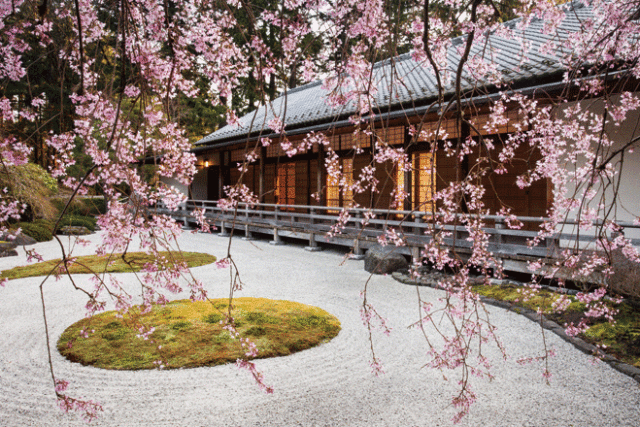
By Shihou Sasaki
The North American Post
This authentic garden has a unique combination of Japanese and Northwest features in its design and landscape. With thousands of visitors every year, the Portland Japanese Garden has been a cultural icon in Oregon.
Located at the site of an old zoo on Portland’s west hill, the garden’s sloping landscape helped to make the 5.5-acres look much larger. Steve Bloom, chief executive officer of the garden, added that Takuma Tono, who built the garden in 1963, integrated five different styles of Japanese gardens into the site like a museum, including Flat Garden, Strolling Pond Garden, Tea Garden, Natural Garden and Sand and Stone Garden.
“The people of Oregon can learn about different styles of Japanese garden, instead of just one particular style of the garden,” he said.
In addition to the landscape’s uniqueness, new leadership in tlast 10 years under Bloom has successfully enlarged the garden’s outreach, which drew over 350,000 visitors last year, compared to 120,000 in 2005.
The number of staff has increased to 50, and is sometimes 75, compared to 15 in 2005, according to Sadafumi Uchiyama, garden curator of the Portland Japanese Garden.
Uchiyama, who joined the garden in 2008, is the garden’s ninth curator. According to him, the curator was sent from Japan for the first twenty years to help complete the garden’s design and train local gardeners. This process helped to shore up the garden’s fundamental values.
“Around the garden, trees were as those are,” he said. “We have a Japanese garden in the Nor thwest’s natural environment.”
Uchiyama added that its location has helped the garden’s popularity. It sits at the edge of the city surrounded by forest.

“We are lucky to have great conditions that have led to this garden being so popular,” he said.
Bloom said that the garden was already beautiful but not very busy, and he recognized its high potential as a place to educate people about Japanese culture. Bloom began promot ing
the garden’s outreach programs and collaborating with the community and other organizations including the art museum and symphony orchestra in Portland.

Building relationships not only in Oregon but in Japan, the last ten years have seen the expansion of the garden itself and the building of a cultural center alongside it.
The Cultural Crossing, which covers 20,191 square feet, will include a cultural education center, an information kiosk and a small tea cafe, office space and three new gardens.
The buildings were designed by Japanese architect Kengo Kuma, who is known as the lead designer of Japan’s new National Stadium for the 2020 Olympics in Tokyo. He will lecture at the University of Washington on April 13 and 14 as part of the Japan Studies’ Mitsubishi Special Lecture Series.
As of early March, a 20-feet-high Ishigaki stone wall was installed by Japanese master mason Suminori Awata, who also built the stone wall in Seattle’s Kubota Garden in 2014.
Bloom said that as of March 18, about $24 million was raised, and he is confident that the garden will reach its $33 million campaign goal by next year when the center is due to open in the Spring.
The garden website says, “As an international thought-leader for Japanese ar ts and culture, we are creat ing additional oppor tunities for more people to expand their knowledge and understanding of the design, meaning, and continuance of Japanese gardens.

the Cultural Crossing development Photos courtesy of Portland Japanese Garden
In the Meiji era, the Japanese garden was one of the featured exhibits that int roduced Japan, Uchiyama said. Japanese gardens have continued to grow even through periods of conflict.
“The Japanese garden is not only beautiful, but there are strong reasons why people want to have these gardens,” he said. “I learned this when we heard about the Japanese garden in Minidoka. There must be some universal sense we can feel and share from Japanese gardens.”
Bloom hopes that the new facility can help train gardeners on how to maintain Japanese gardens. He said that about 300 public Japanese gardens were built from the 1960s to 1980s, mostly as a celebration of new sister city relationships. However there was no visions for the gardens at the time, and many Japanese gardens in North America have had trouble sustaining themselves.
The Cultural Crossing will be completed by Spring 2017, and the garden is expecting up to half a million visitors annually. Bloom said that the new facility will allow more educational, cultural and art programs to educate the general public about Japanese culture.
It will also help strengthen ties with the local community, and can be used as a place for meetings and exhibitions.
“We know that this garden is one of the finest and most authentic Japanese gardens in the world,” Bloom said. “I want to make this into one of the best overall gardens in the world.”
More information can be found at www. japanesegarden.com.






